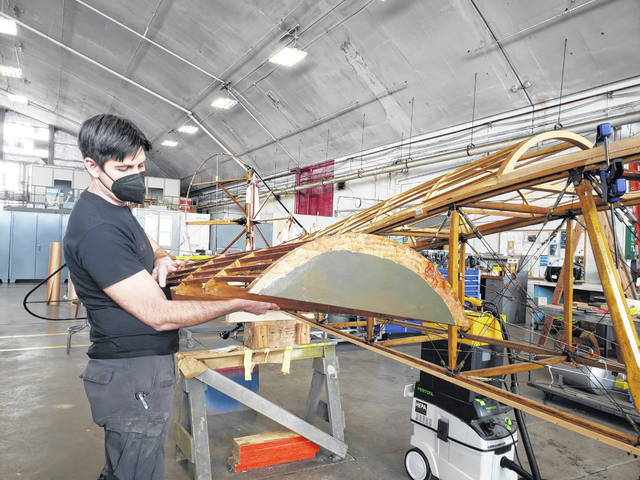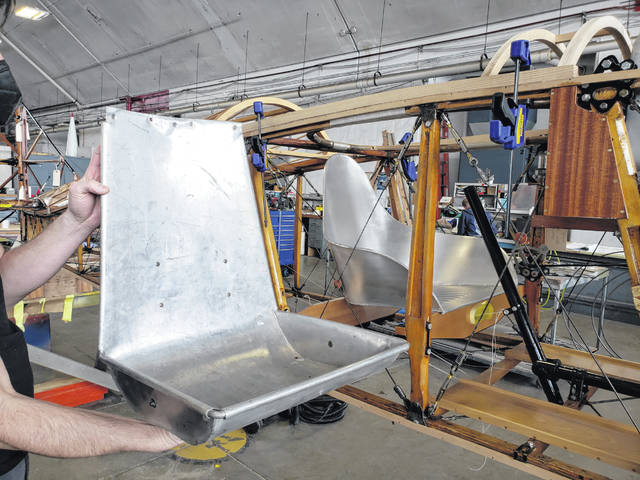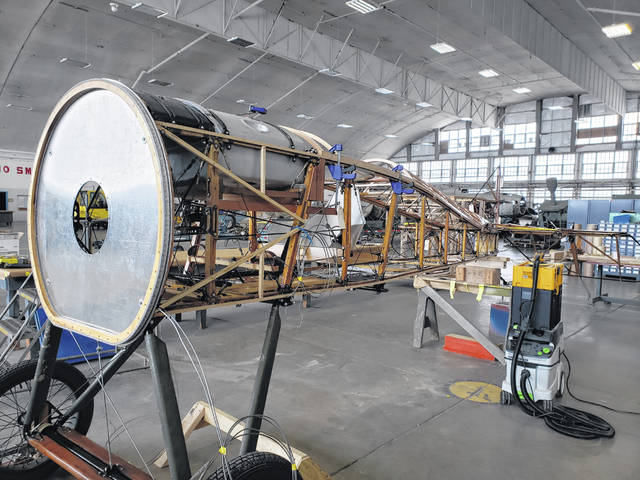


WRIGHT-PATTERSON AIR FORCE BASE — At the Restoration Hangar of Wright-Patterson Air Force Base, staff and volunteers have one of the most detailed tasks in keeping the history of the US Air Force alive and well.
The small group of craftsmen and historians receive worn and broken aircraft, everything from World War I planes to rockets, and ensure that they are safe and accurate, to transport the viewer back in time.
Lead Restoration Specialist Casey Simmons, whose work includes restoring the exterior of the famous Memphis Belle, has currently turned his talents toward a much smaller plane: the Thomas Morse S4C Scout. Colloquially referred to as a “Tommy” back in the day, the craft is tiny compared to the Memphis Belle. Despite its tiny size, there are no shortcuts, as with every project that passes through the Restoration Hangar.
Though less well known than the Belle, the Thomas Morse S4C Scout played an important role during America’s involvement in World War I.
Prior to 1918, the US Army would use old, worn out British and French airplanes to train their pilots. However, the military decided it needed its own fleet of airplanes for training pilots, and the Thomas Morse S-4 Scouts were built for this purpose in 1918. Only 500 were originally manufactured, and less than 20 remain today.
Simmons must have every skill required to handcraft this plane, as do all 13 of his colleagues. Restorers have to have every talent in the book: woodworking, metalworking, sewing, painting, fabrication, welding, and more. Everything from woodworking to metalworking is all done in-house, and they often have to fabricate parts that stopped being manufactured nearly a hundred years ago. Just as much, if not more important, is the dedication of the team to historical accuracy, right down to the metal cables that hold the plane in place.
“American cables are created differently than British or French cables,” Simmons said. “American cables are wrapped around, with gaps in the middle for inspection, while British cables are woven back in on themselves like a Navy splice.”
“It’s the little details like that that you have to be aware of so you know you’re doing the right things,” he added.
Simmons and the three other staff members assigned to the Scout use as much as they can from the original factory blueprints from 1918. The National Museum of the US Air Force kept these records, but only had 25 of the nearly 100 pages of original blueprints. The rest were sourced from a man in California, who over the course of 20 years recreated blueprints in exact detail off of existing planes.
Simmons, who has a degree in archaeology, said that such discoveries are one of the highlights of the job.
“I love that kind of stuff. It’s the little tiny things that make your day,” he said. “Sometimes, though, you never find the answer, and you have to make an educated guess.”
At the start of the process, museum staff assessed whether or not any planes needed repairs or replacements in the World War I gallery. The Thomas Morse, the body of which is covered in a tight layer of cotton, had started to see rips and tears in the aging fabric. In addition, the engine was leaking oil, had run back through the fuselage, and ruined the fabric even further. Once the fabric split down the center, it was time to bring it in for restoration.
Once the restoration team uncovered the plane, they found several incorrect restorations and modifications to the body that had been installed in the 1950s and ’60s. These incorrect restorations had not been done by the museum, but by private collectors who owned the plane in the years after the war.
“In getting into it, we realized a lot of the restoration was wrong,” Simmons said. “Pieces had been replaced and not built correctly.”
After its military service ended, the plane was sold into private hands. The Thomas Morse was still flown in air shows with those modifications up until the 1950s, and NMUSAF acquired the plane in the 1960s.
According to Simmons, it was fairly common for private owners to make modifications to the plane to fit flying standards of the day.
“That just happens over time for an airplane that’s this old,” he said. “It goes into private hands, someone doesn’t like something about it, they make a change that they feel is better, stronger and works for them. But once it comes back to the museum, we gotta be able to take all that away and make it correct.”
Without its fabric skin, the engineering feats of the airplane are on full display. Foot pedals and a single stick control the pitch and yaw, and the plane has the ability to roll. The wooden body of the plane is crisscrossed with thick wires that connect the controls to the elevator, rudder, and wings.
“I personally think they’re so much more interesting with all the fabric off,” Simmons said. “It’s a wooden structured airplane, but it would be nothing without all these flying wires. That’s what trues it up and makes it strong. And you cover it up and nobody sees what’s in there.”
While the plane is not airworthy by today’s standards, it is functional as it would have been in 1918. Much of the woodwork on the main body of the plane is original, over 100 years old.
“You have to be careful with every choice and decision you make to work on it, because once it’s gone, it’s gone,” Simmons said.
Every single plane that is on display in the Air Force Museum has passed through the doors of the Restoration Hangar. Not all of them need such extensive repairs, but each plane arrives on their doorstep because it is a historical artifact.
“These are the record copy for the Air Force. It’s not our mission to make them flyable or airworthy again. A lot of the aircraft we have on display are one of a kind—the only one remaining—so we deem them too valuable to risk losing,” said Rob Bardua, the museum’s public affairs manager.
A typical restoration project takes two years. Though the final cost of restoration for the Scout is yet unknown, the material cost of their most recent project landed at $17,000. Thus far, the Thomas Morse has been cheaper, because the base has an existing stock of quality spruce necessary for the body, which is extremely difficult to source.
Thirteen restorers total are employed by the NMUSAF. Two are typically assigned to “nitpicks,” or little things that need upkeep in the museum proper: a deflated tire here, a moved airplane there. The rest are working on projects, though all the staff pool their skills and time to ensure everything gets done.
As a team lead, Simmons spends about half of his time working on the plane, and the other half doing research.
“We have to know World War I up through stealth fighters,” he said.
The team even works on spacecraft. As Wright-Patterson looks to acquire more and more space-related artifacts in the future, their skills may be needed to work on shuttles, satellites, and more.
The team plans to put the fabric back on the Thomas Morse in April. The plane will be covered with cotton, and painted with a lacquer substance called dope, which shrinks and tightens the fabric against the frame. As with all their materials, the cotton is the same quality with which it was constructed in 1918.
With no delays, the project is expected to be completed by the end of the summer.




